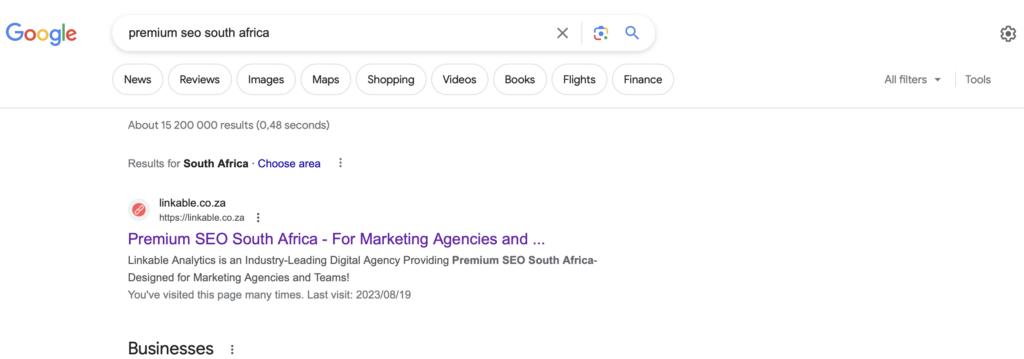Everyone understands that having a strong online presence is of paramount importance for any business to succeed, and what better way to learn on our SEO guide for agencies. One of the most effective strategies to achieve this is through Search Engine Optimization (SEO). By optimising your website with this SEO guide for agencies, you can significantly improve your search engine rankings, attract more organic traffic, and ultimately boost your business’s growth.
SEO operates within the framework of how search engines function. These engines have digital libraries containing vast web page information, along with search algorithms that analyse and rank relevant results for user queries. The primary goal of our SEO guide for agencies is to provide users with the best and most relevant results, which is achieved through the use of web crawlers that examine websites and their performance.
In this comprehensive SEO guide for agencies, we will delve into the intricacies of our SEO guide for agencies and provide you with a step-by-step approach to optimise your website effectively. So, let’s dive in and unlock the full potential of SEO for your business!

Understanding Search Engine Optimisation in this SEO Guide For Agencies
Defining SEO
SEO, which stands for Search Engine Optimization, is a fundamental practice in the world of digital marketing. It encompasses a range of techniques and strategies aimed at improving a website’s visibility and ranking in search engine results. The goal of SEO is to drive organic (non-paid) traffic to a website by ensuring that it appears prominently in search engine results pages (SERPs) for relevant search queries.
SEO involves optimising various elements of a website, including its content, structure, and technical aspects, to align with search engine algorithms. This involves keyword research, on-page optimization, link building, and other tactics to enhance the website’s relevance, authority, and overall visibility.
Effective SEO can significantly increase a website’s organic traffic, improve its online presence, and ultimately lead to higher conversions and business growth.
The Purpose of SEO – Boosting Website Traffic
One of the primary purposes of SEO, or Search Engine Optimisation, is to boost website traffic. SEO techniques and strategies are employed to improve a website’s visibility in search engine results, thereby increasing its chances of attracting organic (non-paid) traffic. By optimising various elements of a website, such as its content, keywords, meta tags, and overall structure, SEO aims to align the website with search engine algorithms.
This alignment helps search engines recognize the website’s relevance to specific search queries, ultimately leading to higher rankings in search results. The higher a website ranks in search results, the more likely it is to be clicked on and visited by users.
As a result, implementing effective SEO practices can significantly enhance website traffic, attract targeted visitors, and create opportunities for increased engagement, conversions, and business growth.
Components of SEO
SEO, or Search Engine Optimization, consists of several key components that work together to improve a website’s visibility and ranking in search engine results. These components include:
Keyword Research:
Identifying and selecting relevant keywords that users are likely to search for when looking for information related to a website’s content or offerings.
On-Page Optimization:
Optimising on-page elements such as meta tags, headings, content, and URL structure to make them more search engine-friendly and relevant to target keywords.
Technical SEO:
Ensuring that the website’s technical aspects, including site speed, mobile-friendliness, and crawlability, are optimised for search engine crawlers to effectively index and rank the site.
Link Building:
Acquiring high-quality backlinks from authoritative and relevant websites, which signals to search engines that the website is trustworthy and deserving of higher rankings.
Content Creation and Optimisation:
Developing high-quality, informative, and engaging content that aligns with user search intent and incorporates targeted keywords naturally.
User Experience (UX):
Enhancing the overall user experience on the website, including easy navigation, fast page loading speed, and mobile responsiveness, to encourage user engagement and satisfaction.
Analytics and Tracking:
Utilising tools like Google Analytics to measure website performance, track organic traffic, and gain insights into user behaviour, allowing for data-driven decision-making and further optimization.
When focusing on these essential components of SEO, businesses can enhance their website’s visibility, attract more organic traffic, and ultimately improve their online presence and conversions.

Photo by Brett Jordan
How Search Engines Work
Have you ever wondered how search engines like Google and Bing magically retrieve relevant information with just a few keystrokes, well don’t worry in this SEO guide for agencies we’ll give you great insight on search engine algorithms?
Behind the scenes, these search engines operate through complex algorithms that crawl, index, and rank websites to provide users with the most accurate and useful search results.
Understanding the basics of how search engines work is essential for anyone involved in SEO or seeking to improve their online presence. In this section, we will delve into the fascinating world of search engines, exploring the key steps involved in the search process.
From crawling and indexing to ranking and displaying search results, we will unravel the inner workings of search engines, empowering you with knowledge to optimise your website and boost your online visibility. So, let’s embark on this enlightening journey to demystify the mechanics behind search engines and discover how you can make them work in your favour.
The Search Engine’s Digital Library and Algorithms
At the core of every search engine lies its digital library, a vast collection of webpages and information that has been crawled and indexed. Think of it as a massive virtual library with billions of books, where each web page represents a unique book. However, instead of physical shelves, search engines use powerful servers and databases to store and organise this vast amount of digital content.
To navigate through this digital library and provide users with relevant search results, search engines employ sophisticated algorithms. These algorithms are like the librarians of the digital library, working tirelessly to understand the intent behind a user’s search query and retrieve the most accurate and valuable information.
Search engine algorithms take into account hundreds of factors when ranking web pages. These factors include keyword relevance, page quality, backlink profile, user experience signals, and more. By analysing these factors, algorithms determine the relevance and authority of webpages, ultimately influencing their position in search results.
Search engine companies continuously refine and update their algorithms to ensure the best possible user experience. This means that SEO professionals and website owners must stay informed about algorithm updates and adapt their strategies accordingly to maintain and improve their search engine rankings.
Understanding the interplay between the search engine’s digital library and its algorithms is crucial for effective SEO. By optimising your website’s content, structure, and technical aspects, you can increase its visibility and relevance in search results, ultimately driving more organic traffic to your site.
Goal – Providing the Best Results
The ultimate goal of search engines is to provide users with the best possible search results. Search engines constantly strive to understand user intent and deliver the most relevant and valuable information in response to a search query. By doing so, they aim to satisfy user needs and ensure a positive search experience.
To achieve this goal, search engines employ a combination of advanced algorithms, data analysis, and machine learning techniques. These algorithms analyse various factors, such as keyword relevance, content quality, user engagement metrics, and website authority, to determine the most appropriate search results.
Search engines also take into account user feedback and behaviour to further refine their results. They monitor metrics like click-through rates, bounce rates, and time spent on a page to gauge user satisfaction and make adjustments accordingly.
For website owners and SEO professionals, understanding this goal is essential. By aligning their strategies and optimising their websites to provide valuable content, seamless user experiences, and relevant information, they increase their chances of ranking higher in search results.
Ultimately, the goal of providing the best results is a win-win situation. Users find the information they are looking for, and website owners gain visibility and traffic. By continually improving their algorithms and refining their methods, search engines strive to enhance the search experience and meet user expectations in an ever-evolving digital landscape.

Photo by Kindel Media:
Crawling and Indexing Process
When it comes to search engines, crawling and indexing are fundamental processes that enable them to discover, organise, and present relevant information to users. Let’s explore how these processes work hand in hand.
Crawling:
Search engines employ specialised programs called crawlers, bots, or spiders to systematically navigate the web. These bots start by visiting a few known webpages, typically those with high authority or popularity. From there, they follow links on those pages to discover new webpages. This process continues as the bots follow links upon links, gradually exploring and covering a vast number of webpages.
During the crawling process, the bots gather information about each webpage they encounter. They analyse the webpage’s content, meta tags, URL structure, and other relevant data. This collected information is then used to determine the webpage’s relevance and its potential to appear in search results.
Indexing:
Once a web page has been crawled, it is added to the search engine’s index, which is essentially a massive database containing information about all the webpages the search engine has discovered. The indexing process involves analysing and categorising the information gathered during crawling. This helps search engines understand the content, keywords, and context of each webpage.
To efficiently index webpages, search engines use algorithms that prioritise and organise the collected data. This allows for faster retrieval of relevant information when users perform a search. The index serves as a reference point for search engines to quickly find and retrieve web pages that match a user’s search query.
It’s important to note that not all web pages are crawled and indexed immediately. Factors like web page popularity, frequency of updates, and relevance determine the crawling and indexing frequency. However, by implementing SEO best practices and ensuring proper website structure, it becomes easier for search engines to crawl and index your web pages efficiently.
The crawling and indexing process is a continuous cycle that search engines perform to keep their indexes up to date and deliver the most relevant results to users.

Photo by Oleksandr P:
Setting Up for SEO Success
Importance of a Proper Domain Name and Self-Hosted Platforms
The Impact of a Well-Chosen Domain Name:
Having a proper domain name is crucial for establishing a strong online presence. A well-chosen domain name not only represents your brand but also influences search engine rankings and user perception. It should be memorable, concise, and relevant to your business or website content.
A domain name that reflects your brand identity can enhance brand recognition and make it easier for users to find and remember your website. Additionally, search engines often consider keywords in domain names as a ranking factor, so incorporating relevant keywords can improve your website’s visibility in search results. It’s worth investing time and effort into selecting a domain name that aligns with your brand and resonates with your target audience.
Harnessing the Power of Self-Hosted Platforms for Website Ownership:
Self-hosted platforms provide website owners with more control, flexibility, and ownership over their online presence. Unlike hosted platforms, which come with limitations and restrictions, self-hosted platforms allow you to have your own domain, customise your website design, and access a wide range of features and plugins.
With a self-hosted platform, you have the freedom to tailor your website to meet your specific needs and preferences. It also gives you the ability to scale your website as your business grows.
Additionally, self-hosted platforms provide better control over data and privacy, as you have full ownership and can manage security measures.
Leveraging the power of self-hosted platforms, you can establish a professional and unique online identity, optimise your website’s performance, and have the freedom to evolve and expand your online presence in line with your business goals.
Delivering a Great User Experience
When it comes to website success, providing a great user experience is paramount. A positive user experience not only encourages visitors to stay longer on your site but also entices them to return and engage with your content. Here are some key factors to consider for delivering a great user experience:
Responsive Design:
With the increasing use of mobile devices, it is essential to ensure your website is responsive and adapts seamlessly to different screen sizes. A responsive design enables users to access and navigate your site effortlessly, regardless of the device they are using.
Intuitive Navigation:
A clear and intuitive navigation structure is vital for helping users find the information they need quickly and easily. Organise your website’s content logically and use user-friendly menus and navigation tools to guide visitors through your site.
Fast Loading Speed:
Slow-loading websites can frustrate users and drive them away. Optimise your site’s loading speed by minimising file sizes, leveraging caching techniques, and optimising server performance. A fast-loading website enhances the user experience and encourages users to explore more of your content.
Engaging and Relevant Content:
Deliver high-quality, valuable content that is relevant to your audience’s needs and interests. Make your content engaging, easy to read, and visually appealing by incorporating multimedia elements such as images, videos, and infographics. This not only enhances the user experience but also encourages sharing and boosts your website’s credibility.
Clear Call-to-Action:
Guide users towards desired actions on your website with clear and compelling call-to-action (CTA) buttons or links. Whether it’s signing up for a newsletter, making a purchase, or filling out a contact form, a well-placed CTA helps users navigate through your website and take the desired actions.
Consistent Branding:
Maintain a consistent branding across your website, including colours, fonts, and imagery. Consistency creates a cohesive and professional look, reinforcing your brand identity and helping users build trust and familiarity with your website.
Keyword Research
Significance of Keyword Research for SEO
Keyword research holds immense significance in the realm of SEO. It serves as the foundation for optimising your website’s content and improving its visibility in search engine results. By conducting thorough keyword research, you gain valuable insights into the language, preferences, and search behaviour of your target audience.
This understanding allows you to tailor your website’s content, meta tags, headings, and other elements to align with the keywords and phrases users are searching for. By strategically incorporating relevant keywords into your website, you enhance its relevance to search queries and increase its chances of ranking higher in search results.
Effective keyword research not only helps drive organic traffic to your site but also enables you to uncover new opportunities, stay ahead of industry trends, and create valuable content that resonates with your audience.
Ultimately, keyword research plays a vital role in optimising your website for search engines, improving its discoverability, and attracting relevant visitors who are more likely to engage with your content and convert into customers.
Significance of Finding Seed Keywords
Finding seed keywords is a critical step in the keyword research process. Seed keywords are the foundation upon which you build your keyword strategy. Here’s why finding seed keywords is significant:
Initial Exploration:
Seed keywords serve as a starting point for your keyword research journey. They help you explore the broad topics and themes that are relevant to your website or industry. By identifying seed keywords, you can begin to uncover the core concepts and subjects that users might search for.
Uncovering Related Keywords:
Seed keywords act as a springboard for discovering related keywords and phrases. As you delve deeper into your keyword research, you can expand upon the initial seed keywords to identify long-tail keywords, variations, and specific queries that your target audience may use. This process allows you to create a comprehensive keyword list that covers a range of user intents.
Targeting Audience Needs:
Seed keywords help you align your content with the needs and interests of your target audience. By understanding the broad topics users are searching for, you can develop content that directly addresses their queries and provides valuable information. This targeted approach enhances the relevance and usefulness of your content, ultimately attracting and engaging the right audience.
Niche Identification:
Seed keywords can help you identify specific niches within your industry. By analysing related keywords and identifying patterns, you may discover niche areas that are less competitive or underserved. This presents an opportunity to create specialised content and target a specific audience segment, giving you a competitive advantage.
Content Strategy Development:
Seed keywords play a vital role in shaping your content strategy. They provide direction and inspiration for creating meaningful and informative content that aligns with user search intent.
By incorporating seed keywords into your content planning, you can ensure that your website offers valuable information that resonates with your target audience.
Seed keywords lay the foundation for your SEO efforts, enabling you to uncover related keywords, target audience needs, identify niches, and develop a robust content strategy.
Using Keyword Research Tools – Ahrefs and SEMrush
When it comes to conducting effective keyword research, utilising keyword research tools can significantly enhance your capabilities. Two popular and powerful tools in the realm of SEO are Ahrefs and SEMrush. Let’s explore how these tools can assist you in your keyword research endeavours.
Ahrefs:
Ahrefs is a comprehensive SEO toolset that offers a wide range of features, including a robust keyword research tool. With Ahrefs, you can uncover valuable keyword insights to optimise your website’s content and improve its visibility in search engine results. Here’s what Ahrefs brings to the table:
Keyword Analysis: Ahrefs provides in-depth keyword analysis, allowing you to explore keyword search volume, keyword difficulty, and keyword ideas. You can discover relevant keywords and evaluate their competitiveness, enabling you to target the most impactful keywords for your website.
Competitor Research: A key strength of Ahrefs is its competitor analysis capabilities. You can analyze competitor websites to identify the keywords they are ranking for, uncover content gaps, and gain insights into their SEO strategies. This information helps you refine your own keyword strategy and stay competitive in your industry.
Content Optimization: Ahrefs assists in optimising your content by providing suggestions and recommendations for improving keyword usage. You can analyse the keyword density, relevance, and placement within your content to ensure it aligns with best SEO practices.
SEMrush:
SEMrush is another popular SEO tool that offers a robust keyword research feature. It provides a comprehensive suite of tools to help you optimise your website and improve your search engine rankings. Here’s what SEMrush brings to the table.
Keyword Research: SEMrush offers a comprehensive keyword research tool that enables you to explore keyword ideas, search volume, and keyword difficulty. It provides valuable insights into the keywords your competitors are targeting and helps you identify long-tail keyword opportunities.
Competitive Analysis: SEMrush allows you to analyse your competitors’ websites and their keyword strategies. You can identify their top-ranking keywords, track their performance, and discover new keyword opportunities based on their success.
Content Planning: SEMrush assists in content planning by providing topic suggestions, related keywords, and content optimization recommendations. This helps you create high-quality, optimised content that aligns with user intent and search engine requirements.
Both Ahrefs and SEMrush offer powerful features and insights that can significantly enhance your keyword research efforts. They provide valuable data, competitive analysis, and content optimization suggestions to help you optimise your website and improve your search engine rankings.
On-Page SEO
Definition of On-Page SEO
On-Page SEO refers to the optimization strategies and techniques implemented directly on individual webpages to improve their visibility and search engine rankings. It involves optimising various elements within the webpage itself to make it more relevant, user-friendly, and easily understandable by search engines.
On-Page SEO focuses on factors such as content quality and relevance, proper keyword usage, meta tags optimization (including title tags and meta descriptions), URL structure, internal linking, and overall website architecture.
These optimizations aim to provide a better user experience, align the webpage with search engine algorithms, and increase the chances of higher rankings in search engine results pages (SERPs).
By implementing effective On-Page SEO practices, website owners can enhance their website’s visibility, attract organic traffic, and improve their chances of reaching their target audience.
Optimizations for Website Pages
When it comes to optimising website pages, there are several key areas that require attention to improve visibility, user experience, and search engine rankings. Here are some essential optimizations to consider:
Relevant and Engaging Content: Creating high-quality, relevant, and informative content is crucial. Focus on providing valuable information that aligns with user search intent. Incorporate targeted keywords naturally within the content to enhance its relevance to search queries.
Title Tags and Meta Descriptions: Craft compelling and keyword-rich title tags that accurately represent the content of each webpage. Similarly, write concise and enticing meta descriptions that encourage users to click through to your webpage from search results.
URL Structure: Optimise your web page URLs to be descriptive, readable, and keyword-rich. A well-structured URL not only helps search engines understand the content but also makes it easier for users to navigate and share the page.
Heading Tags: Use proper heading tags (H1, H2, H3, etc.) to structure your content hierarchically. Heading tags not only improve readability for users but also signal to search engines the importance and organisation of the content.
Image Optimization: Optimise images by reducing file sizes without compromising quality and adding descriptive alt tags. This ensures faster page loading times and provides alternative text for search engines to understand the content of the images.
Internal Linking: Incorporate internal links within your content to guide users to related and relevant pages on your website. Internal linking helps search engines discover and index other pages while providing users with a seamless browsing experience.
Mobile-Friendly Design: Ensure your website pages are optimised for mobile devices. With the increasing use of smartphones, a responsive design is crucial for providing a positive user experience across different screen sizes.
Page Speed Optimization: Improve page loading speed by minimising file sizes, leveraging caching techniques, and optimising server performance. A faster-loading webpage improves user experience and can positively impact search engine rankings.
Schema Markup: Implement structured data markup using schema.org vocabulary to provide additional context and information about your webpage’s content to search engines. This can enhance search result snippets and help search engines understand your content better.
Content Optimization for SEO
Focus on Creating Quality Content for the Audience:
Creating high-quality, informative, and engaging content should be the primary focus of your SEO strategy. By understanding your target audience’s needs, pain points, and interests, you can craft content that resonates with them. Provide valuable insights, solutions, or information that addresses their specific concerns.
By delivering content that genuinely benefits your audience, you not only enhance their experience but also increase the likelihood of them engaging with your website and sharing your content with others.
Including Main Keyword in the Title and URL:
Incorporating your primary target keyword in the title and URL of your content is essential for optimising its visibility in search engine results. By including the keyword, you signal to both users and search engines what the content is about.
This improves the relevance of your page and increases the chances of ranking for that specific keyword. However, it’s important to ensure that the inclusion of the keyword feels natural and doesn’t compromise the readability or user experience.
Writing Compelling Meta Descriptions and Using Internal and External Links:
Crafting compelling meta descriptions is crucial as they act as a concise summary of your content in search results. A well-written meta description accurately represents the content and entices users to click through to your website.
Additionally, incorporating both internal links (linking to other pages within your site) and external links (linking to authoritative external sources) adds value to your content. Internal links help users navigate your website and establish connections between related pages, while external links provide additional context and credibility to your content.
Proper Use of Headings and Keyword Placement Throughout the Content:
Utilising headings and subheadings appropriately (e.g., H2, H3) helps structure your content and improve readability. It allows readers to scan and understand the main points of your content more easily. Additionally, strategically placing relevant keywords throughout your content can enhance its search engine visibility.
However, it’s crucial to use keywords naturally and avoid keyword stuffing, which can have a negative impact on your SEO efforts. Focus on creating valuable and user-friendly content, and incorporate keywords in a way that feels organic and seamless.
Off-Page SEO and Link Building
Off-page SEO and link building are crucial components of a comprehensive SEO strategy as set our in our SEO guide for agencies. They involve activities conducted outside of your website that have a significant impact on its perception, authority, and visibility in search engine rankings. Let’s explore the importance of off-page SEO and how it can positively influence your website’s rankings.
Importance of Off-Page SEO and Its Impact on Rankings:
Off-page SEO focuses on building your website’s credibility and authority in the eyes of search engines. While on-page optimization is essential, off-page factors heavily influence how search engines perceive the value and relevance of your website.
By acquiring high-quality backlinks from authoritative websites, your website gains validation and signals to search engines that your content is trustworthy and valuable. Off-page SEO helps improve your website’s rankings, increase organic traffic, and ultimately boost your online visibility on search engine results pages (SERPs).
Creating a Social Media Presence and Content Marketing:
Establishing a strong presence on social media platforms can significantly impact your off-page SEO efforts. By actively engaging with your audience, sharing valuable content, and promoting your website’s resources, you can increase brand visibility and attract potential customers.

Photo by Mikael Blomkvist:
Social media platforms also provide an avenue for content marketing, allowing you to create and distribute valuable content that resonates with your target audience. Guest posting on reputable websites and creating shareable content further enhance your chances of earning valuable backlinks.
Influencer Outreach and Sharing Content on Forums:
Engaging with influencers in your industry can yield significant benefits for your off-page SEO efforts. Collaborating with influencers on content creation or having them share your content with their followers can amplify your reach, increase brand exposure, and generate valuable backlinks.
Additionally, participating in relevant online forums and communities provides an opportunity to share your expertise, answer questions, and share valuable resources like this SEO guide for agencies. This can lead to increased visibility, brand recognition, and the acquisition of valuable backlinks from authoritative sources.
Generating Links Towards the Website and Building a Link Building Profile:
Creating linkable assets is a powerful way to attract natural backlinks to your website. By developing informative infographics, research papers, comprehensive guides, or other valuable resources, you increase the likelihood of other websites linking to your content as a reference.
Building a diverse and authoritative link profile is essential for improving your website’s domain authority and search engine rankings. It’s important to focus on acquiring backlinks from reputable and relevant sources, as quality matters more than quantity in link building.
Conclusion
Our SEO guide for agencies provides a comprehensive overview of Search Engine Optimization and its importance in establishing a strong online presence. By following the strategies outlined in this guide, agencies can significantly improve their website’s visibility, attract organic traffic, and ultimately boost business growth.
In our SEO guide for agencies we explored the intricacies of SEO, including the components that make up an effective optimization strategy. From keyword research and on-page optimization to off-page SEO and link building, each aspect plays a vital role in improving search engine rankings and attracting the right audience.
Understanding how search engines function and the goal of providing the best results allowed us to delve into the mechanics behind search algorithms and the importance of aligning your website with their requirements. By optimising your website’s content, structure, and technical aspects, you can increase its relevance and visibility in search results.
We also discussed the significance of delivering a great user experience, which involves responsive design, intuitive navigation, fast loading speed, engaging content, and clear call-to-action. These elements contribute to a positive user experience and encourage visitors to stay on your site, engage with your content, and take desired actions.
The guide highlighted the importance of conducting keyword research and utilising tools like Ahrefs and SEMrush to uncover valuable insights and optimise your content. We explored the significance of finding seed keywords, targeting audience needs, and developing a content strategy that resonates with your target audience.
On-page SEO optimizations, such as relevant and engaging content, title tags, meta descriptions, URL structure, heading tags, image optimization, internal linking, and mobile-friendly design, were discussed in detail. According to our SEO guide for agencies these optimisations improve the visibility and usability of your website, ultimately enhancing its search engine rankings.
Off-page SEO and link building were also emphasised as critical factors in establishing your website’s credibility and authority. Building a social media presence, engaging in content marketing, influencer outreach, and participating in online forums can all contribute to earning valuable backlinks and improving your off-page SEO efforts.
By implementing the strategies outlined in our SEO guide for agencies, you can unlock the full potential of SEO and drive organic traffic to your website. Remember, SEO is an ongoing process that requires continuous monitoring, adaptation to algorithm updates, and staying informed about industry trends.




